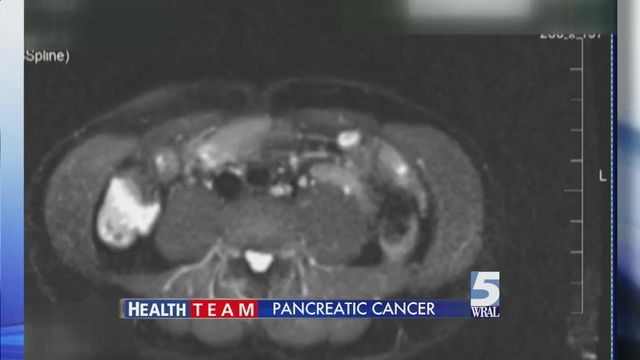Fighting pancreatic cancer proves tough but possible
A diagnosis of pancreatic cancer is among the most devastating to those who face it. For most patients, once the symptoms lead them to a doctor, the cancer has spread and the prognosis is bleak.
Posted — UpdatedFor most patients, once the symptoms lead them to a doctor, the cancer has spread and the prognosis is bleak.
Those symptoms, for 54-year-old Chris Wilsey, began with a cramp after a lunch in January 2015. That night he could barely sleep.
"It was unbearable," Wilsey said. "Absolutely the worse pain I've ever felt."
He went to the emergency room but tests offered no answers. A doctor asked him to describe his pain on a scale of 1 to 10.
"I was calling it about a 9 and a half," Wilsey said, "and (then it) went to Zero. The pain just disappeared right after the CT scan."
The only concern was a shadow show on his pancreas in the CT image. A subsequent MRI revealed a serious problem: that bright spot on the right.
"(The spot) is the tumor itself," said Duke surgeon Dr. Christopher Watters. "You do see the tail of the pancreas beyond that."
Further tests, though, showed it had not yet spread.
Watters told Wilsey it was a rare and not necessarily aggressive type of tumor called a neurocystic-endocrine tumor, which occurs about four times for every million people.
It was the same type that Apple Computers founder Steve Jobs had, but Jobs chose not to have surgery and later died from it.
Wilsey followed Watters' advice to remove it. The tumor being isolated in the tail of the organ made the surgery less complex.
"If you're getting rid of the tail of the pancreas, there's no reconstruction to do, you simply get rid of it," Watters said.
Pancreatic tumors, though, are typically not found before they spread and cause symptoms.
"This was a bit of a stroke of luck just because whatever made the abdomen hurt that day allowed us to find this," Watters said.
For Wilsey, the pain was telling him something.
"I interpreted it as a message, and I'm sure it was," Wilsey said. "It was a message I'm glad I listened to."
Watters says Wilsey's case was rare, but it's a mistake to assume pancreatic tumors are always a death sentence.
He says there are often many options for treatment.
• Credits
Copyright 2024 by Capitol Broadcasting Company. All rights reserved. This material may not be published, broadcast, rewritten or redistributed.





